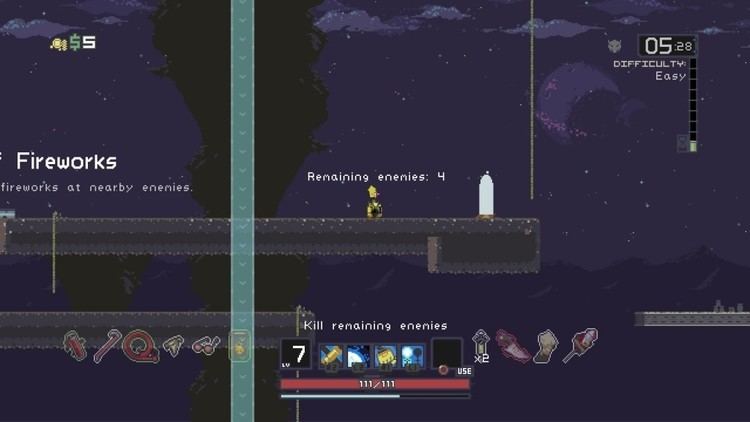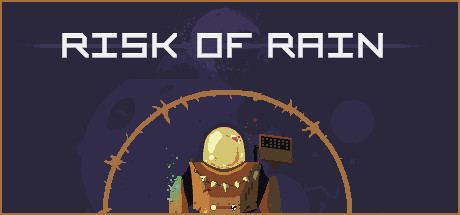9 /10 1 Votes9
4.4/5 GOG Artist(s) Duncan Drummond Initial release date 19 November 2013 Publisher Chucklefish Games | 9/10 Steam Developer(s) Hopoo Games Composer(s) Chris Christodoulou | |||||||||||||||||||||||||||||||||
 | ||||||||||||||||||||||||||||||||||
Producer(s) Duncan DrummondPaul Morse Designer(s) Matthew GriffinDuncan DrummondPaul Morse Modes Single-player video game, Multiplayer video game Similar Starbound, Deadbolt, Stardew Valley, Rogue Legacy, Spelunky | ||||||||||||||||||||||||||||||||||
wtf is risk of rain
Risk of Rain is a platform video game incorporating roguelike elements, developed by a two-student team from the University of Washington under the name Hopoo Games. The game, initially a student project, was funded through a Kickstarter campaign to improve the title, and was published by Chucklefish Games to Microsoft Windows in November 2013. OS X and Linux versions premiered as part of a Humble Bundle in October 28, 2014. Ports for the PlayStation 4 and PlayStation Vita, developed with assistance from Code Mystics, were released on April 12, 2016.
Contents

The player controls the survivor of a space freighter crash on a strange planet. As the player progresses through levels, selected randomly and with some procedural placement of objects within the level, they attempt to survive by killing monsters and collecting items that can boost their offensive and defensive abilities. The game features a difficulty scale that increases with time, requiring the player to choose between spending time building experience and completing levels quickly before the monsters become more difficult. By discovering various hidden locations, players can discover artifacts which can alter gameplay. The game supports up to four cooperative players in online play and up to two players in local play..

Gameplay

At the start of the game, each player selects one of twelve characters. Initially, only one character is available, but as the player completes various in-game objectives, more characters become available. Each character has various statistics and a set of unique moves; for example, the sniper has the ability to hit creatures from a long distance for large, piercing damage but their firing rate is slow, while the commando can do rapid, moderate damage at close range.

Within all but the last level of the game, the goal is to locate a teleporter, placed in a random location. As the players hunt for it, they will encounter monsters; upon death the monsters will drop in-game money and will also provide the players experience. As the players gain experience they will increase the player level, gaining more hit points and stronger attacks. Money can be used to open various chests, buy items at stores, activate attack drones that aid in combat, or pray at shrines that have a random chance of dropping items, described by game lore as the space freighter's cargo. There are over 110 items in the game, and these provide benefits such as passive bonuses that improve offensive or defensive capabilities, or a special usable with a cooldown. Players can only hold one useable at any time, but they can collect many passive items, including multiple versions of the same item, stacking the benefits of these items. The location of these items is randomly determined through roguelike procedural generation.
Once the players have found the teleporter, they activate it, starting a 90-second countdown on Drizzle (easy) and Rainstorm (medium) difficulty and a 120-second one on Monsoon (hard) and the players have to survive. During this time, many more monsters, including at least one boss character (if the Kin artifact is not active), will appear. After the countdown is over, no new monsters will appear but the players will have to defeat all remaining monsters before they can use the teleporter and proceed to the next level. At this time, any remaining money the players have is converted to experience points. At the penultimate level, the players have the option of taking the teleporter to the final level (the crashed ship), or to use the teleporter to run through much higher difficulties of previous levels so as to gain more experience and items; when this latter option is taken, the teleporter on these levels will allow the same choice to either proceed to the final level or continue through additional levels. On the final level, the player must fight a final boss character which if they survive, they are able to escape the planet and win the game.
The difficulty of the game is determined by a timer. The difficulty level increases every 5 minutes up through 10 levels, with newly spawned monsters having more health and stronger attacks. Additionally, boss characters may spawn before the players have found teleporters on higher difficulties. If playing alone, the game is over when the player dies. In multiplayer mode, a player that dies must wait until the other players survive to the next level, upon which they are brought back into play.
The item drops are based on the various progress the player has made in the meta-game through repeated playthroughs. For example, defeating certain boss characters for the first time will unlock an item that can then drop in future playthroughs. Other items are based on completing certain goals, such as winning the game a number of times, or performing specific goals with each of the characters. In Rainstorm or Monsoon modes, monsters will also rarely drop log books that describe the monsters; this itself is used to unlock more items and a playable character.
Development
Risk of Rain was developed by two students at the University of Washington, Duncan Drummond and Paul Morse, later releasing the game under the name Hopoo Games. The two took inspiration from their favorite games in the past and combined them into a single package, focusing primarily on the platformer and roguelike genres. They also wanted to add the idea of a game that scales in difficulty that "puts the player in a sense of urgency and makes them make tough choices often". Risk of Rain was developed using the GameMaker: Studio tool. The title Risk of Rain was selected not only to allow the game to be easily searchable via the Internet, but came to allude to the concept of a single protagonist in the large game world always worried about "a risk of failure or bad things happening".
The original idea Drummond and Morse had for their game, which they started developing as sophomores, was a tower defense where the difficulty of the attacking creatures would rise with the distance that they were from the defense point, but they found that players would opt to avoid venturing from that point. They sought to find a means to force the player to keep moving and came to the idea of "difficulty = time" concept. Though this is implemented so that it appears that the difficulty increases every five minutes to the player, internally, a difficulty counter is incremented every minute as to create an apparently smoother transition to the player. This counter translates into a semi-exponential growth in newly-created enemies' attack strength, a semi-logarithmic growth in these enemies' health points, and a logarithmic growth in the rate that the player's health increases with character level. Drummond and Morse found this created favorable gameplay that created moments of "highs and lows" and keep the player on edge, having times where the player may feel overpowered to the enemies and moments later find themselves in a struggle to stay alive. Another mechanic they had explored with the "difficulty = time" approach was to incorporate the speed at which the player defeated enemies into the difficulty counter, but found this removed the "highs and lows" in the game.
Another element of the difficulty approach was the rate which enemies are generated. The game uses an artificial intelligence (AI) system that "buys" enemies to spawn at random intervals using a point system; this AI is given points at a rate that scales with the difficulty counter. Enemies have point values, with more difficult enemies costing more points, and the AI will buy as many as it can. Due to limitations with GameMaker, Drummond and Morse found that having too many enemies spawn in stressed the game, so created a means for the AI to buy an "elite" enemy if it were to otherwise buy five of a single type; these elite enemies have additional attributes, such as higher attack values, and present a harder challenge to kill. They found this workaround created extra dynamism for the game, which Drummond called as "a merge of game functionality and game design". Risk of Rain was tested primarily to balance the difficulty system, and Drummon and Morse were aware that with all the available items to collect in the game, it is possible to "break the game" by acquiring specific combinations of item drops which would make the player overpowered or invincible. They believe this was still acceptable since this was highly tied to the game's random generator.
The game is presented in 8-bit-like two-dimensional graphics. This economy of graphics allowed them to both develop sprites for new enemies easily, but also allowed them to give a sense of scale to the larger bosses compared to the player's character. Character designs were made to provide enough differences between classes, and to give abilities that relied on the player's skill to give the player satisfaction of playing well, such as introducing a damage boost on the sniper's gun if the player times their reload appropriately.
After completing most of the core game on their college budgets, the Hopoo Games team turned to Kickstarter to gain additional funds to update the game to the latest version of GameMaker, obtain a musician to provide music for the game, and additional quality control. The Kickstarter was launched in April 2013 seeking $7,000, and ended up with more than $30,000 in backers. This allowed them to get Chris Christodoulou to compose the game's soundtrack and add several additional gameplay features to the title. The success of the Kickstarter led to a publishing partnership with Chucklefish, Ltd., providing them server space and forums for the game's players. They would later gain help of Matthew Griffin, from Yeti Trunk, another developer that has worked with Chucklefish, to help improve the game's multiplayer code.
The Hopoo team announced in February 2014 that they were working with Sony Computer Entertainment America to bring the game to the PlayStation Vita. With assistance from Code Mystics, Hopoo announced that the game will also come to the PlayStation 4 alongside the Vita version; these versions will support an online matchmaking system and the ability for two local players to join with other online players. The PlayStation versions also support cross-platform play, enabling both PlayStation 4 and Vita players to play together.
Reception
Risk of Rain was named one of the Student Showcase winners of the 2014 Independent Games Festival, and subsequently won the Student Prize Award.
